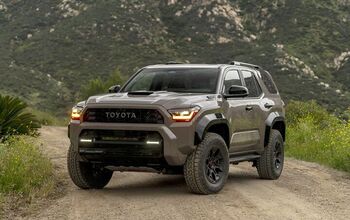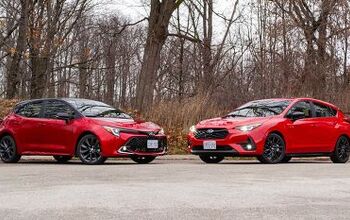2012 Chevrolet Orlando Review
It’s not often that automakers go to the trouble of bringing a car to Canada, but refrain from selling it in the United States. With one tenth the population and different homologation laws than the United States, the costs rarely make it worthwhile for automakers to import unique products to the Canadian market.
FAST FACTS
| 1. Powering the Orlando is a direct-injection 2.4-liter 4-cylinder making 174-hp, mated to either a six-speed manual or automatic. |
| 2. Fuel economy is rated at 10.6 L/100km in the city and 6.9 L/100km on the highway (for the automatic), or roughly 22/34-mpg. |
| 3. The Orlando seats seven and has a total cargo space of 56 cu-ft (1,594 liters) of cargo room. Unlike the Mazda5, the second row doors don’t slide. |
| 4. Available in Canada and other countries around the world, the Chevy Orlando is not for sale in America. |
Typically, the exceptions to the rule are vehicles like the Mercedes-Benz B-Class or Nissan X-Trail – compact utility vehicles that are fuel efficient and priced in the lower end of their segments. With vehicle prices around 30% higher than the United States, and fuel prices beyond $5/gallon, Canadians tend to buy vehicles similar to those purchased by European consumers.
Get a Quote on a New ChevroletThe Chevrolet Orlando is one such vehicle intended for world markets that will not make it to America, but will be sold in Canada thanks to its low prices, a small footprint and efficient 4-cylinder engine. According to GM Canada, American engineers wanted to include features like knee airbags to help the Orlando meet an obscure American crash test regulation, but the cost of this change would have made the venture unprofitable. Since the vehicle already met every other unified North American standard, it was an easy choice to sell it in Canada, where the Mazda5 enjoys brisk sales and a near monopoly on the small minivan market.
SHARES PLENTY WITH THE CRUZE
The Orlando is built in Korea and engineering was largely overseen by GM Daewoo (yes, that Daewoo), GM’s Korean engineering arm. GM Daewoo also worked on the Cruze compact car, a vehicle that has gained widespread market acceptance, even if it’s no longer the pinnacle of compact car engineering. That’s not to say it’s a bad car by any means, the Orlando is lucky to benefit from a number of similarities with the Cruze.
The interiors of the two vehicles are aesthetically identical, with the same plastic pieces, stereo interface and HVAC controls shared between the two cars. One neat difference is a stereo head unit that flips up to reveal a cubby hole that can be used for sunglasses, iPods and other small items that need to be concealed. Frankly, we hope to see it on a lot more cars in the future, and it’s an example of how one well thought-out idea can endear us to a pretty mundane vehicle.
CRUDE ENGINE DOES THE JOB, GETS EXCELLENT FUEL ECONOMY
Of course, we mean that in the best way possible. The Orlando isn’t a total bore to drive, but the 2.4L Ecotec 4-cylinder engine and 6-speed gearbox do not hold up their end of the bargain. The engine feels coarse under hard acceleration and makes noises like an agricultural vehicle, although the power is certainly in place. The 6-speed automatic, as seen on the Cruze and other vehicles, has long been an enemy of ours, with its clumsy operation and gear hunting on inclines doing little to change our opinions. GM claims 22-mpg in the city and 34-mpg on the highway (our conversion), which is certainly better than one would find in a larger minivan, and bests the 21/28-mpg rating of the Mazda5. A 6-speed manual is also offered, but we skipped it entirely, as the market for this unit is probably smaller than those Canadians who favor privatized healthcare or more lax gun laws.
Our Orlando LT model (the trim level we expect most buyers to opt for) rode smoothly on the back roads of Ontario’s Muskoka region (Canada’s version of the Hamptons), where roads aren’t always repaved annually. We also found the Orlando to be fairly quiet save for some wind noise emanating from the A-Pillar, an issue that we also experienced with the Cruze.
During our drive, we sampled the third row of seats, and found that they provided an adequate amount of room for fully-grown passengers. A multi-hour road trip may not be preferable, but going across town on errands wouldn’t be so bad. The second row is similarly spacious without any of the claustrophobia that sets in on drives longer than 60 minutes.
THE VERDICT
Aside from the Mazda5 (or perhaps the larger Dodge Journey), there’s not much else on the market similar to the Orlando. In fact, the Orlando reminds us of the original Honda Odyssey, which also used conventional doors, an efficient 4-cylinder engine and a third row of seats to compete with more conventional minivans. That Odyssey, which sold from 1995-1998, was a massive flop in North America but did gain a devoted cult following (and a popular taxi in New York City) among those who wanted utility without any of the excess of a traditional minivan. The Odyssey was the right vehicle for the wrong time, but with a general trend towards downsizing, and some very aggressive pricing (the Orlando starts at a $20,325), value conscious shoppers in Canada will likely flock to their nearest Chevy dealership.
Related Reading
2012 Mazda5 Review
2012 Toyota Prius v Review
2010 Chevrolet Equinox Review
2009 Honda CR-V Review
2011 Toyota RAV4 Review
2011 Dodge Grand Caravan Review
LOVE IT
- Unsurpassed practicality
- Drives like a Cruze, packaged like a minivan
- Excellent value for money
LEAVE IT
- Powertrain is woefully unrefined
- Some NVH issues that should have been dealt with
More by Derek Kreindler































Comments
Join the conversation